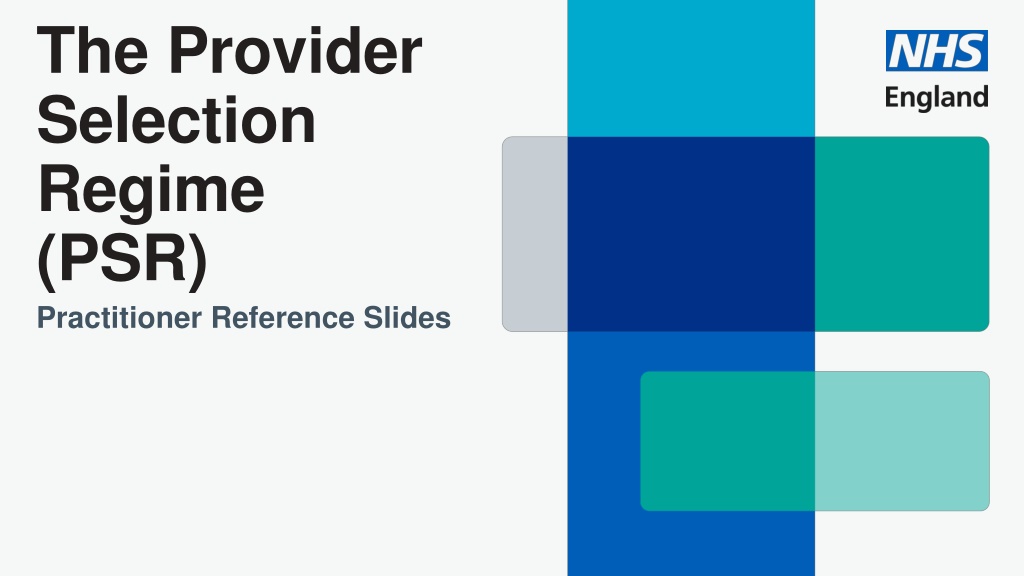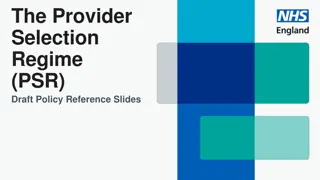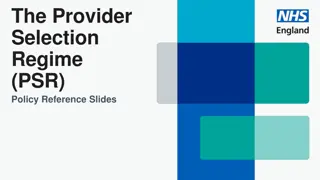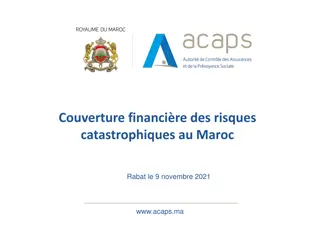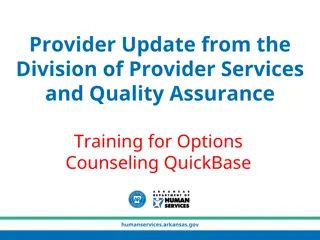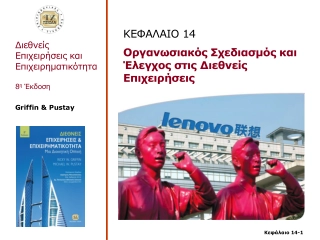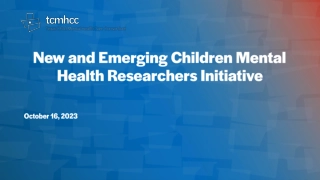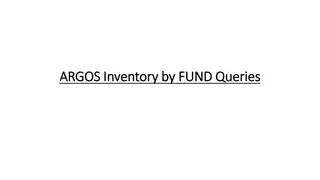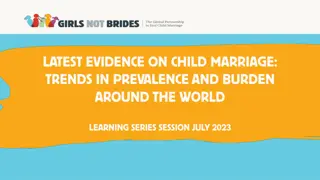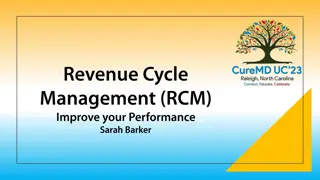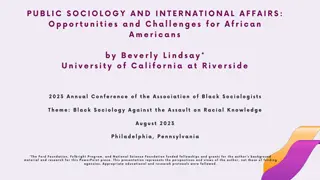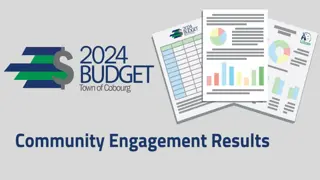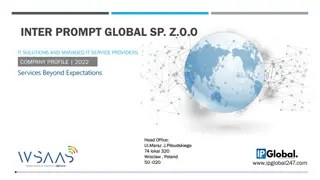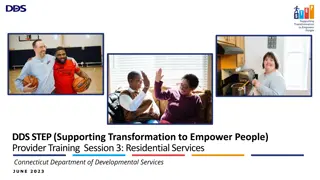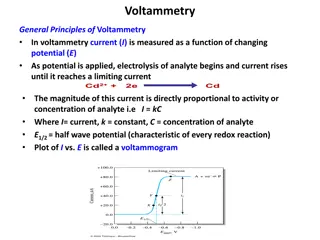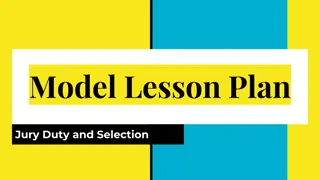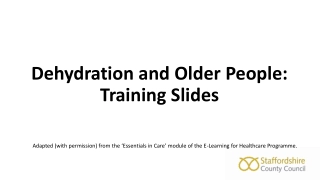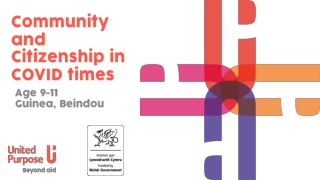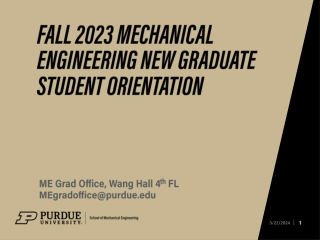Understanding the Provider Selection Regime (PSR): Practitioner Reference Slides
Reference slides supporting relevant authorities in applying the new Provider Selection Regime (PSR) in healthcare services procurement in England. The slides provide guidance on PSR regulations and statutory recommendations, with details on the selection processes, transparency requirements, decision reviews, and more. The PSR implementation toolkit includes overview, policy, and practitioner slide decks for comprehensive understanding and practical application.
Download Presentation
Please find below an Image/Link to download the presentation.
The content on the website is provided AS IS for your information and personal use only. It may not be sold, licensed, or shared on other websites without obtaining consent from the author. Download presentation by click this link. If you encounter any issues during the download, it is possible that the publisher has removed the file from their server.
Presentation Transcript
The Provider Selection Regime (PSR) Practitioner Reference Slides
The Provider Selection Regime (PSR) Practitioner Reference Slides These reference slides are intended to support relevant authorities with their application of the new Provider Selection Regime (PSR); however, they are not exhaustive and should not be used as guidance. Relevant authorities must follow the regulations and associated statutory guidance when applying the PSR. Throughout this slide deck requirements set out in the PSR regulations that relevant authorities must comply with are denoted by blue circles in the top left corner. The relevant regulations are inserted into the middle of the circle. Throughout this slide deck recommendations by NHS England as set out in the statutory guidance are denoted by orange circles in the top left corner.
PSR implementation toolkit This slide deck is aimed at procurement practitioners who will be applying the PSR day-to- day. This slide deck is part of the PSR implementation toolkit, containing the following: Overview slide deck, providing a quick introduction to the PSR and is aimed at senior leaders Policy slide deck, providing some more detail about the key features of the PSR and is aimed at commissioners and procurement leads Practitioner slide deck (this one), providing in-depth information about the steps in the PSR processes and is aimed at practitioners End-to-end process maps for all provider selection processes in the PSR, aimed at practitioners FTS guide, providing information about which notices need to be published on FTS and is aimed at practitioners Flow-charts, providing a visual representation of some of the key processes in the PSR. 3 |
How to use these slides These slides cover: a brief overview of the PSR, including its aims and scope a walkthrough of the PSR provider selection processes, including: the direct award processes (direct award processes A, B, and C) the most suitable provider process the competitive process the transparency requirements reviewing decisions during the standstill period contract modifications how to return to an earlier step in the process or abandon a selection process
Legislative changes The Health and Care Act 2022 introduced a new procurement regime for selecting providers of healthcare services in England: the Provider Selection Regime (PSR). The PSR came into force on 1 January 2024 and replaced: Public Contracts Regulations 2015 when arranging health care services National Health Service (Procurement, Patient Choice and Competition) Regulations 2013. The relevant authorities (RAs) required to follow the PSR when procuring health care services, irrespective of whether the providers they are considering are from the NHS, the independent, or the voluntary sector are: NHS England Integrated Care Boards (ICBs) NHS trusts and NHS foundation trusts Local authorities or combined authorities
Aims of the PSR The PSR has been designed to introduce: a flexible and proportionate process for selecting providers of health care services so that all decisions are made in the best interest of people who use the services 1. the capability for greater integration and enhanced collaboration across the system, whilst ensuring that all decisions about how health care is arranged are made transparently 2. opportunities to reduce bureaucracy and cost associated with the current rules. 3.
Procurement principles Regulation 4 The procurement principles require relevant authorities to act: with a view to secure the needs of the people who use the services, including through integrated service delivery 1. with a view to improve the quality of the services, including through integrated service delivery 2. with a view to improve the efficiency of the services, including through integrated service delivery 3. 4. Transparently, fairly, and proportionately.
Other obligations When exercising functions to comply with the PSR, relevant authorities must continue to comply with other legal obligations. These include the: 2006 Act Local Government and Public Involvement in Health Act 2007 Equality Act 2010 Modern Slavery Act 2015 Local Authorities (Executive Arrangements) (Meetings and Access to Information) (England) Regulations 2012 Subsidy Control Act 2022. Relevant authorities should also be aware of other requirements and duties not set out in legislation. Central government commercial policies should be considered and applied where relevant.
Scope Regulation 3, Schedule 1 The PSR applies to the procurement of health care services in England. Broadly, services within scope are: Not in scope of the PSR are: goods (i.e., medicines, medical equipment, personal protective equipment) services arranged by the NHS such as hospital, community, mental health, primary health care, palliative care, ambulance, and patient transport services for which the provider requires CQC registration social care services non-healthcare services or health- adjacent services (i.e., capital works, business consultancy, catering) that do not provide health care to an individual. substance use treatment services, sexual and reproductive health, and health visits arranged by local authorities.
Mixed Procurements Regulation 3 The PSR allows relevant authorities to arrange a contract comprising of a mixture of in- scope health care services and out of scope services or goods when both of the below statements are true: The main subject matter of the procurement is health care services. This means that the health care service element must be more than 50% of the value of the contract. 1. The relevant authority is of the view that the other goods or services could not reasonably be supplied under a separate contract. This means that the relevant authority is of the view that procuring the health care services and the other goods and services separately would, or would be likely to, have a material adverse impact on the relevant authority s ability to act in accordance with the procurement principles. 2.
Mixed Procurements Regulation 3 Examples of the types of services that may require an element of mixed procurement: Patient transport, which includes health care services (for which the provider requires CQC registration) and non-health care service (where no CQC registration is required) Mental health aftercare services, such as support services arranged under Section 117 of the Mental Health Act Discharge to assess services Section 75 partnership arrangement or joint commissioning between local authority and ICBs Prison services, asylum seekers services and veteran services which include health care
Record Keeping Regulation 24 Relevant authorities must keep records of their considerations throughout the award process. These records may be requested as part of a review during the standstill period. Records must include: the relative importance of each of the key criteria and the rationale for their relative importance and how the basic selection criteria were assessed name and address of the provider the decision-making process followed to select a provider the rationale for the decision for mixed procurements, how the procurement meets the requirements for mixed procurement details of the individual/individuals making the decision any declared or potential conflicts of interest for individuals involved in decision making and how these were managed. 12 |
Making a Decision Regulation 6 Relevant authorities must identify which provider selection process is applicable for the health care service they are arranging. The processes are: Direct award processes: A, B, and C The most suitable provider process Competitive process
Overview of direct award process A Regulation 6 Regulation 7 There is an existing provider. Direct award process A must be used. There is no realistic alternative to the existing provider due to the nature of the health care services. Direct award process A cannot be used to award a contract for a newly established service. A provider must already be in place for the service in question. Direct award process A cannot be used to establish a framework agreement. 14 |
Overview of direct award process B The relevant authority offers a contract to all providers eligible. Regulation 6 Regulation 8 Patients are offered a choice of providers. The number of providers is not restricted by the relevant authority. Direct award process B must be used. Patients are offered a choice of providers. The relevant authority has arrangements in place to enable providers to express an interest in providing the health care services in question. The relevant authority offers a contract to all eligible providers. Direct award process B must be used to award contracts for existing and newly established services, provided that all the criteria, as detailed above, are met. Direct award process B cannot be used to establish a framework agreement. 15 |
Overview of direct award process C Regulation 6 Regulation 6(5) Regulation 9 There is an existing provider for the healthcare services, and their contract is ending. The proposed contracting arrangements are not changing considerably. Direct award process C may be used. The relevant authority is of the view that the existing provider is satisfying the original contract and is likely to satisfy the proposed contract to a sufficient standard. The relevant authority is not required to follow Direct Award Processes A or B. Direct award process C cannot be used to award a contract for a newly established service. Direct award process C cannot be used to establish a framework agreement. 16 |
Regulation 6(5)Overview of the most suitable provider process Regulation 6 Regulation 10 The relevant authority is not required to follow Direct Award Processes A or B, and does not wish to or cannot follow Direct Award Process C. The most suitable provider process may be used. The relevant authority is of the view, taking into account likely providers and all relevant information available to the relevant authority at the time, that it is likely to be able to identify the most suitable provider. The most suitable provider process cannot be used to establish a framework agreement. Relevant authorities are advised to follow this provider selection approach only when they are confident that they can, acting reasonably, clearly identify all likely providers capable of providing the relevant health care services. 17 |
Overview of the competitive process Regulation 6 Regulation 6(5) Regulation 11 The relevant authority is not required to follow direct award processes A or B. The competitive process must be used. The relevant authority cannot or does not wish to follow direct award process C or the most suitable provider process. The relevant authority wishes to establish a framework agreement. 18 |
Getting to the right decision Regulation 6
Overview of the direct award processes The direct award processes were designed to allow relevant authorities the flexibility to: take a proportionate approach when selecting a provider award a contract without running a competitive exercise develop sustainable and integrated partnerships with providers. If the circumstances for direct award processes A and B are met, a contract may be awarded without observing a standstill period. The contract award notice must be published. 20 |
Overview of direct award process A Regulation 6 Regulation 7 Step 1: Start: RA establishes that there is only one realistic provider for the service. Existing provider s contract is coming to an end. Step 3: Step 2: RA publishes notice confirming award. RA awards the contract. 21 | RA: relevant authority
START & STEP 1 of direct award process A Regulation 6 Regulation 7 START: the existing provider s contract is coming to an end. STEP 1: the relevant authority must establish that there is no realistic alternative to the existing provider. Examples of services that may fall under direct award process A: Type 1 and 2 urgent and emergency services and associated emergency inpatient services 999 emergency ambulance services NHS urgent mental health crises services 22 |
STEPS 2 & 3 of direct award process A Regulation 7 Schedule 2 Once the relevant authority established that there is only one realistic provider, then they can award the contract to that provider. Step 2 Next, they must publish a notice setting out that they have awarded a contract. This must be done using the Find a Tender Service (FTS) website, including the information required under Schedule 2. This notice must be published within 30 days of the contract award. Step 3 23 |
Overview of direct award process B Regulation 6 Regulation 8 Step 1: START: RA sets any qualifying criteria, ensuring there are arrangements for providers to express interest in the service. The RA wishes to provide, or currently provides an unrestricted patient choice service. Step 3: Step 2: RA publishes notice confirming award. RA awards contract to each eligible provider. 24 | RA: relevant authority
START of direct award process B Regulation 6 Regulation 8 The relevant authority intends to, or is providing a service where: patients have a choice of providers 1 the relevant authority is not restricting the number of providers from which patients can choose 2 the relevant authority will offer contracts to all providers to whom an award can be made 3 If a relevant authority wants to restrict the number of providers that patients can choose from, then they cannot use this approach, and must use direct award process C, the most suitable provider process or the competitive process instead. 25 |
STEP 1 of direct award process B Regulation 6 Regulation 8 Relevant authorities must ensure that there are arrangements in place to enable providers to express an interest in providing the service. They must set out: a description of the health care services to be provided 1. how a provider can express their interest in providing the service 2. any minimum requirements that providers must meet 3. 26 |
STEPS 2 & 3 of direct award process B Regulation 8 Schedule 2 Once the relevant authority have met the requirements set out in Step 1, then they can award contracts to all eligible providers. Step 2 Next, the relevant authority must publish a notice setting out that they have awarded a contract. This must be done using the Find a Tender Service (FTS) website, including the information required under Schedule 2. This notice must be published within 30 days of the contract award. Step 3 27 |
Summary of direct award processes A & B Regulation 6 Regulation 7 Regulation 8 These processes must be used in the previously defined circumstances. When using these processes to award a contract, the relevant authority does not need to refer to the key criteria (covered in slide 30). This is not the case for the other processes. Once the relevant authority has decided that one of these is the appropriate process to use, they can award a contract. The sole transparency requirement is to publish a contract award notice. This is in contrast to the other processes, which require a number of additional transparency notices to be published. When following either of these processes, the standstill period (covered in slide 61) does not have to be observed. This is not the case for the other processes. 28 |
Steps in common for the below provider selection processes Next, the following provider selection processes will be covered: Direct award process C 1 . 2 . 3 . The most suitable provider process The competitive process These have a number of common features: The use of the key criteria and the basic selection criteria 1 . 2 . 3 . the standstill period must be observed multiple transparency notices must be published 29 |
Key criteria and the basic selection criteria Regulation 5 Regulation 19 Schedule 16 When following direct award process C, the most suitable provider process, or the competitive process, the relevant authority must take into account the key criteria and the basic selection criteria. Quality and innovation basic selection criteria The provider s ability to pursue a particular activity Value key criteria Integration, collaboration, and service sustainability Economic and financial standing Improving access, reducing health inequalities, and facilitating choice Technical and professional ability Social value 30 |
Key criteria Regulation 5 When assessing a provider against the Key Criteria, all five Key Criteria must be considered, and none can be discounted. However, the relative importance of the criteria is not pre- determined and there is no prescribed hierarchy or weighting for each criterion. Example 3: Pass/Fail Example 1: Equal weighting Example 2: Unequal weighting Social value 20% Social value 10% Social value 15% Improving access, reducing health inequalities, and facilitating choice 50% Improving access, reducing health inequalities, and facilitating choice 20% Improving access, reducing health inequalities, and facilitating choice 15% Value Must meet minimum standard 40% Value 20% Value 25% Integration, collaboration, and service sustainability 20% Integration, collaboration, and service sustainability 20% Integration, collaboration, and service sustainability Quality and innovation Must meet minimum standard Quality and innovation 25% Quality and innovation 20%
Basic selection criteria Regulation 19 Regulation 20 Schedule 16 The relevant authority must also assess providers against the basic selection criteria and is expected not to award a contract to a provider that does not meet these. These may relate to: a provider s ability to pursue a particular activity, e.g., a requirement to hold a specific authorisation or membership of a professional organisation necessary economic and financial standing, e.g., a minimum annual turnover, holding indemnity insurance necessary technical and professional ability, e.g., a certain level of experience, not having conflicting interests Furthermore, the relevant authority should not award a contract to a provider that meets the exclusion criteria. 32 |
Overview of direct award process C Regulation 6 Regulation 9 *Step 1: START: The existing provider s contract is coming to an end. *Step 2: Step 3: RA publishes Intention to Award a Contract notice. RA reviews whether the existing provider is doing a sufficiently good job, and likely to continue to do so. RA confirms that the new contract is not changing considerably. Step 6: RA publishes Contract Award notice Step 5: RA awards contract. Step 4: RA observes the standstill period. * These steps in the process may be carried out in the reverse order or simultaneously. 33 | RA: relevant authority
START of direct award process C Regulation 6(5) There is an existing provider in place whose contract is coming to an end. The relevant authority wishes to award a new contract, for the same services, to the same provider again. The existing provider wishes to continue providing the services. The relevant authority cannot use direct award process A and direct award process B. 34 |
STEP 1 of direct award process C Regulation 9 Once the relevant authority has established that the service is not changing considerably, they must assess whether the existing provider is: Satisfying the existing contract (according to the detail outlined in the existing contract), taking into account the key criteria and applying the basic selection criteria. AND Be likely able to satisfy the new contract to a sufficient standard (according to the detail outlined in the new contract), taking into account the key criteria and applying the basic selection criteria. To do this, the relevant authority must decide on the relative importance of the key criteria for the service in question, before assessing the existing provider s performance with regard to each of the key criteria. 35 |
STEP 2 of direct award process C Regulation 6(5) Regulation 6(10) A change is deemed considerable if: the proposed contracting arrangements are materially different in character to the existing contract when that existing contract was entered into or ALL the following apply: the change is attributable to a decision made by the relevant authority the lifetime value of the proposed new contract is at least 500,000 higher than the lifetime value of the existing contract when it was entered into the lifetime value of the proposed new contract is at least 25% higher than the original lifetime value of the existing contract when it was entered into. 36 |
STEP 2 of direct award process C Regulation 6(5) Regulation 6(10) Regulation 6(11) The considerable change threshold is not met where: The material difference applies solely as a result of a change in the identity of the provider following corporate changes, for example a takeover or merger and NONE of the following apply: the change is attributable to a decision made by relevant authority the lifetime value of the proposed contract is at least 500,000 or higher than the lifetime value of the existing contract the lifetime value of the proposed contract is at least 25 % or higher than the lifetime value of the existing contract 37 |
STEP 2 of direct award process C Regulation 6(5) Regulation 6(10) Regulation 6(12) The considerable change threshold is not met where: The proposed contracting arrangements are not materially different in character and ALL of the following apply: the changes are attributable to decision made by the relevant authority due to external factors beyond its control (for example, change in patient volumes, or due to indexing) lifetime value of the proposed contract is at least 500,000 or higher than the lifetime value of the existing contract the lifetime value of the proposed contract is at least 25 % or higher than the lifetime value of the existing contract 38 |
Regulation 6(5) Regulation 6(10) Regulation 6(11) Regulation 6(12) STEP 2 of direct award process C In summary, a contract award procedure may continue under direct award process C if: The new contract (including its value) is identical to the previous contract (the same services will be provided). Any change to the contract is minor and does not materially change the nature of the contract (and the associated services provided). The change is caused by external factors such as inflation or changes in patient volume, or it s a change due to a merger or takeover. The change in value of the proposed new contract is less than 500,000 over the original value of the existing contract. The change in value between the existing and proposed new contracts does not equal to or exceed 25% of the lifetime value of the existing contract. If these conditions are not met, then the change is deemed considerable and direct award process C must not be used to award the contract. 39 |
Regulation 6(5) Regulation 6 (10) Regulation 6(11) Regulation 6(12) STEP 2 of direct award process C START Yes May continue with direct award process C Is the new contract identical to the previous contract? No Are the proposed contracting arrangements materially different in character to the existing contract when that existing contract was entered into? Is the change to the contract below the value element of the considerable change threshold and does not make the proposed contract materially different in character? Yes No No Yes Are any of the below true: the change to the proposed contract attributable to a decision of the relevant authority the change in value over 500,000 the change is over 25% of the value of the existing contract when that existing contract was entered into? Are the proposed contracting arrangements materially different in character only because of change in provider identity, for example, due to a merger? No Yes Is the change to the value of the proposed contract in response to external factors beyond the control of the relevant authority and the provider? Yes May continue with direct award process C Yes No Considerable change, must not use direct award process C 40 |
Regulation 6(5) Regulation 6(10) Regulation 6(11) Regulation 6(12) STEP 2 of direct award process C Relevant authority holds a contract with an original value of 3 million. The contract is coming to an end and the relevant authority wants to continue with the current provider but wishes to add 1 million to the contract value. Change in the value of the contract = 33% of the original contract value (> the 25% threshold) Change in the value of the contract = 1 million (> the 500,000 threshold). Therefore, this is a considerable change, and the relevant authority must not continue to award the contract under Direct Award Process C. Relevant authority holds a contract with an original contract value of 1 million. It has made a contract modification that increases the value of the contract by 400,000. The contract is now coming to an end and the relevant authority wishes to keep the modification in the new contract. The change in the lifetime value of the contract = 40% (> the 25% threshold.) Change in value of the contract = 400,000 (< the 500,000 threshold) Therefore, this is not a considerable change, and the relevant authority can proceed with the approach under direct award process C. 41 |
STEP 3 of direct award process C Regulation 9 Once the relevant authority has confirmed that the service is not changing considerably and the provider is satisfying the existing contract and likely to satisfy the new contract, they must publish their intention to award a contract notice. This must be done using the Find a Tender Service (FTS) website. The information that must be included in the notice is detailed in Schedule 3 of the Regulations. The standstill period starts the day after the publication of this notice. This, and all subsequent steps, are identical across direct award process C, the most suitable provider process, and the competitive process. Therefore, these steps and any subsequent steps will be described later in the presentation. 42 |
Overview of the Most Suitable Provider Process Regulation 10 Guidance Step 1: Step 2: Step 3: Start: Provider s contract is coming to an end, or a new service needs to be established. RA undertakes a pre-market engagement exercise. RA considers the key criteria and decides their importance for the service. RA considers that it can identify the most suitable provider without a competitive process. Step 5: Step 7: Step 6: Step 4: RA contacts providers it is considering. RA publishes a notice of their intention to follow the Most Suitable Provider Process. RA assesses the providers identified and chooses the most suitable provider(s). RA requests additional information from providers, if necessary. Steps established by the Regulations. Relevant authorities must comply with these. Steps recommended by NHS England and are described in the statutory guidance. Step 8: Step 9: Step 10: RA awards the contract. RA publishes a notice of their attention to award a contract. RA observes the standstill period. 43 | RA: relevant authority
START of the most suitable provider process Regulation 6 Regulation 6(6) Regulation 10 Guidance Relevant authorities may consider using the most suitable provider process when: The existing provider s contract is coming to an end, or the existing provider is not able to continue providing the service, or a new service needs to be established. 1. The relevant authority cannot use direct award processes A or B, and either cannot or does not wish to follow direct award process C. 2. If the above circumstance are met, the relevant authority may consider using the most suitable provider process or the competitive process. 44 |
STEP 1 of the most suitable provider process Guidance Relevant authorities are expected to be aware of the provider landscape within the relevant geographical footprint (i.e., local, regional, national). Pre-market engagement is an important tool to ensure that relevant authorities have a sufficiently detailed understanding of the market. When using the most suitable provider process, relevant authorities are advised to undertake pre-market engagement to help them identify all suitable providers and develop the service specification. They may do this through: market research regular engagement with providers a register of relevant providers engaging with providers who have previously expressed interest in delivering similar services 45 |
STEP 2 of the most suitable provider process Regulation 5 Regulation 10 The relevant authority must consider the requirements for the new service and must consider the key criteria and the basic selection criteria, including their relative importance. The key criteria are: Quality and innovation 1. Value 2. Integration, collaboration, and service sustainability 3. Improving access, reducing health inequalities, and facilitating choice 4. Social Value 5. Relevant authorities are advised to carefully consider the relative importance of the value criterion. 46 |
STEP 3 of the Most Suitable Provider Process Regulation 10 Guidance Relevant authorities are expected to consider all the providers they think will be able to deliver the services and consider whether they will be able to identify the most suitable provider to deliver the healthcare services to the relevant population (local/regional/national). It is advised that relevant authorities follow this provider selection approach only when they are confident that they can, acting reasonably, clearly identify all likely providers capable of providing the relevant healthcare services. If relevant authorities are unable to identify the most suitable provider, then they must use the competitive process. 47 |
STEP 4 of the most suitable provider process Guidance The relevant authority has identified a number of suitable providers and is planning to select the most suitable provider from this group. The relevant authority is advised to inform all providers it is considering. This should not be through a published notice; it can be through e-mail or verbally. This step is to help ensure that when the intention to follow the Most Suitable Provider Process notice is published (next step), providers being considered do not unnecessarily contact the relevant authority to express their interest in providing the service in question. This would also allow the providers being considered to let the relevant authority know if they are unable to provide the services. 48 |
STEP 5 of the most suitable provider process Regulation 10(2) Schedule 5 The relevant authority must publish a notice setting out their intention to follow the most suitable provider process. This must be done using the Find a Tender Service (FTS) website. The information that must be included in the notice is detailed in Schedule 5 of the Regulations. The relevant authority must publish the notice at least 14 calendar days before assessing the providers against the key criteria. 49 |
STEP 6 of the most suitable provider process Guidance The notice published in Step 5 allows all providers to learn about the intention of the relevant authority to award a contract for a particular service using the most suitable provider process. At this point interested providers could contact the relevant authority and ask to be considered as the most suitable provider . The relevant authority is advised to consider these requests to help them identify all suitable providers. The relevant authority may ask the providers they are considering (including those that expressed an interest following the publication of the notice from Step 5) for further information. This can help them evaluate the likely providers. 50 |
